From theatre to kitchen design: Nikki Van Boeyen’s unusual journey
Catching up with the COO of Gipman Kitchens & Cabinetry in Cranbrook
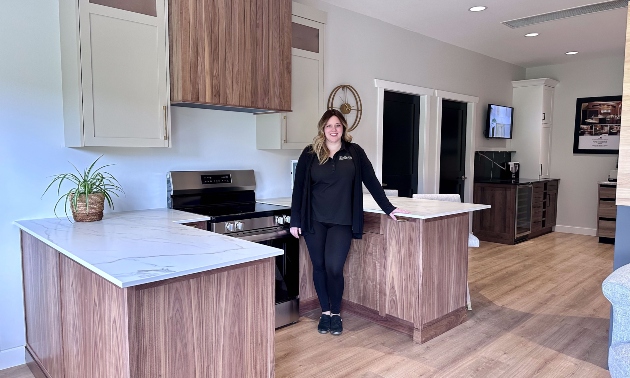
Nikki Van Boeyen uses her diverse skill set to help bring clients' dreams to life. — Kerry Shellborn photo
As the chief operations officer for Gipman Kitchens & Cabinetry in Cranbrook, Nikki Van Boeyen brings a unique blend of creativity and precision. Her role can include everything from overseeing daily operations to designing dream kitchens for clients, and her varied skill set serves her well (she has a background in theatre, kinesiology, and a minor in Japanese!)
Van Boeyen sat down with us to discuss her career evolution, and to share how her array of talents contribute to an innovative approach in the cabinetry industry.
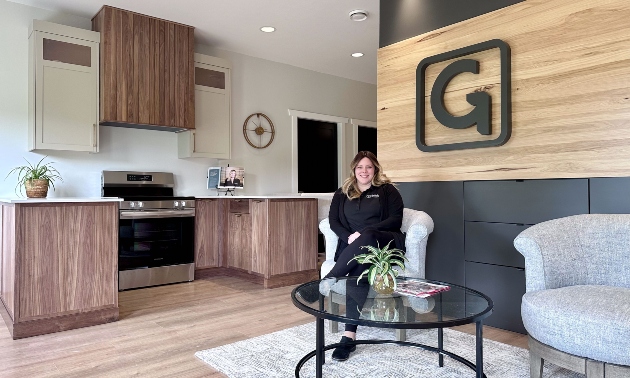
- Kerry Shellborn photo
Who are you and what do you do?
I'm Nikki Van Boeyen. I am the chief operations officer. I oversee the whole facility, daily operations, kitchen designs, building the business, site measures and installs.
Tell me about your journey, where you started and how you got to where you are today.
I was born and raised in Cranbrook, went away to university for seven years in Lethbridge, and got my degree in theatre, kinesiology, and a minor in Japanese. I really loved learning everything I could. I was working at Starbucks as a manager, making $12 an hour, so I needed a better paying job and my parents connected me with a cabinet shop that was looking for a receptionist. They hired me and I started my journey into cabinetry. Obviously being born and raised by my parents, I was no stranger to any part of the process. We grew up above the shop, so my after-school chores weren't, “Clean your room, and empty the dishwasher,” they were, “Go help your mom stain that. Your dad's gonna cut parts on the table saw so you need to edge band them and run the CNC.” So when I started at Adora I was really familiar with what was happening.
My boss came to me one day and he said, “Hey Nikki, our design team is really far behind and your dad uses the same cabinet design software as we do. What are the chances you know how to use it and design basic kitchens?” I was like, “No problem! I can definitely do that.” He's like, “Awesome! On Monday I'll set you up with the engineering team, they'll run you through a few things that we do specifically and you're off to the races.”
He left the front and I picked up the phone. I called my dad and he asked why I was calling him in the middle of the day. I said, "I just lied to my boss. I told him I know how to design kitchens, and I'll be home tomorrow for a crash course." "Got it!" he said. I drove home after work that night and the next day my dad gave me a crash course on using the program and designing kitchens. I went to work on Monday and they had no idea that I didn't actually know what I was doing and I spent six months designing kitchens for them.
Can you tell us a bit about your parents?
Garold and Carole Gipman started the company in 1988 before I was born, and my dad started in cabinetry when he was 13 years old. So he had been doing this for over 50 years.

- Kerry Shellborn photo
Tell me how your love of theatre transposed. Are you able to use some of those skills today?
Definitely. I was doing theatre management, so you oversee the different departments of a production, the props department, costumes, set building, sound, lighting, the actors, you're at every rehearsal managing the blocking and making sure everybody has what they need. And then, then once the show goes through tech week, like the stage manager takes it over from the director, and it's their show to hold the integrity of, and oversee everything. Then you're managing the audience in the front of house staff, and you're running crews. So a theatre production is a big thing. I was lucky that I got into it at Mount Baker when Rod was doing it—he was great and inspired me to go on and learn more, so I went to university.
I've worked in theatre since I was 15 years old. It is super fun and it really translates into the cabinetry industry and what we do here because you're overseeing the customer and their inspiration, and bringing the design together. That's really comparable to working with a director and making sure the ideas they have in their head are coming to life on the stage. Then the learning curve in cabinetry and product variability is wild, but I just kind kind of equate that to the same in theatre in that you can go mystical you can go historical you can go really modern and funky—there are so many different ways to tell the same story there's so many different renditions of Shakespeare out there. You're pulling that vision out of the client and into the home and then production is over.
How many employees are you directing here?
Six. We've got two in the front. We've got Donna, who is our main salesperson and designer. I oversee what she's working on with clients, because it's such a steep learning curve there's so many things you can do in cabinetry and you can do it a bunch of different ways. So it's just making sure that the vision she's pulling out of the customer's head is translating to the way the machinery works and the best way to construct it. I oversee what she's doing and I work with some customers myself.
And then Connie is our coordinator. Once we've sold the job she orders all the materials, warehouses everything, and makes sure that we have everything in time. Then the two of them organize installs and schedules and oversee who's ready for what and when.
In the shop we have three. We have Colin, he's been with us almost 25 years. We've got Claude, he's been with us five, but he's been in the industry. forever and Martin came to us last year and he's our finisher. So we've got two super talented cabinet makers that have been doing this forever and we've got Martin who is the world's most incredible finisher. He does a great job and the three of them are just a powerhouse. They can put out so much cabinetry. It's wild. We have a very automated shop so everything goes through and they're overseeing the equipment and the product that it's putting out.
Then we have our installer Josh, he's been with us I think pushing three years now and he's incredible. He gets raves from all of our customers, he's just so good so personable and very respectful of being in people's homes. That's so important when you're in people's homes as a living.
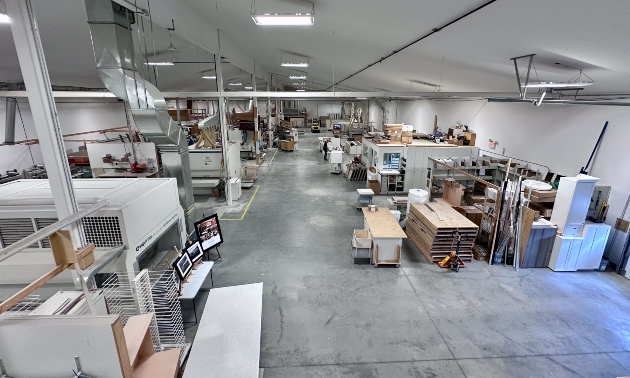
- Kerry Shellborn photo
How much technology is involved in the design process?
We design everything in our cabinet design software and it does everything from the floor plan, your elevations, 3D models of it, and then two clicks of a button and it's on the machines in the back and the machines are processing it. It's really clean and what's designed is what gets produced.
So while it's all handcrafted, it's handcrafted in a consistent way so you get machine error instead of human error—it's easier to catch a machine's mistakes.
Can you tell me about the scope of the projects you take on?
We do big show homes all over the valley. We work everywhere from Nelson, Trail, Creston and Kimberley, all the way up into Golden, and then over into Sparwood and a little bit in Southern Alberta. So we serve the whole area. We've got installers in different areas—we supply the cabinetry to them and they install it.
We handle large and small projects, from working on big, high-end homes to apartments, closets, laundry rooms, and other small spaces. We build all of our own products in-house, so people come to us for cabinet doors and then they'll go home and re-face it, so we work with the DIY people.
Some DIY people just want to do countertops, so we help them figure out all of that and bring it to life. There's not really anything that's impossible.
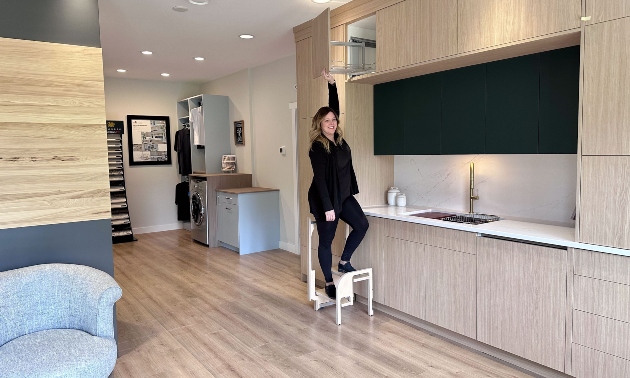
- Kerry Shellborn photo
Tell me about some of your projects where you worked with a client to help them see the vision
We do a lot of residential, but we also do a lot of commercial, and my favourite project in the last five years was working with the Steeples Veterinary Clinic on their big renovation. I learned so much about fear-free veterinary practice and how specific colours and patterns are better for animals and actually reduce their stress.
I worked with Ruth and we designed the whole facility with that in mind. It was such a cool experience and it turned out unbelievably beautiful. Fear-free is about choosing colours and a colour palette that naturally settles that anxiety. Really bold, bright, vibrant colors are stressful to animals. So working in more neutral, soft tones and a very specific level of blues and greens, interestingly enough. Then learning about how animals and owners interact within their space and how to settle that anxiety.
They have four exam rooms and then they have a dedicated cat-only exam room because dogs produce different smells than cats. I remember one meeting we were sitting there with Ruth and we were talking about the reception area. She wanted to put in some benches with a special spot for cats. But her concern was the flow-through as cats typically come in a carrier. She found that when people put carriers on the floor or next to them, the cats get stressed because they can't see their owner (and they're face-to-face with other animals that might come up and sniff.)
We decided to adapt the cat bench so when you sit down there’s actually a ledge at the back to put the carriers on.
What about challenges?
Well, it's well-known that renovating is one of the top five most stressful periods in somebody's life and and that's our business. We have to have ways of not letting it get to us, and being calm, cool and collected when the customer is frustrated. When cabinetry goes in that's almost the last piece of the puzzle, and it can seem like the project's never going to end. I think being able to manage stress is important. It always comes together. It always works out.
It taught me early on to really dive in. When we go into someone's house there's a whole demo and fixing phase—that can be anywhere from one week to to six weeks, depending on the scope of the project. And then we deliver cabinetry. People think that when construction is happening there's going to be people in their house all day every day, and that's kind of true. So we just set out that these are the days we will be in your house. It might be a little bit more. It might be a little bit less. Our installer goes in and gets his job done, then the stones one week out so you're not sitting there with unfinished cabinets for weeks on end waiting for counters. They're the next week. We wrap up a whole kitchen reno in two weeks.
However, in construction, something might happen. Something might get damaged. I might need to order in another sheet—but we're always honest and clear with people. There are very few delays, but it happens and we get it fixed. Since we build everything here, there's been the odd time we mismeasured something or something changed on the job site from when we measured. They can call me and I can have a new box on the machine right away and delivered on-site in 45 minutes. That's such a big difference when working with a local cabinet maker.
When you work with people that bring in cabinets from other areas, that issue goes back into the manufacturer's queue and it could be 8 to 12 weeks again to get a replacement part.
How would you define success?
I think if you love what you do and take pride in it, you're going to be successful.
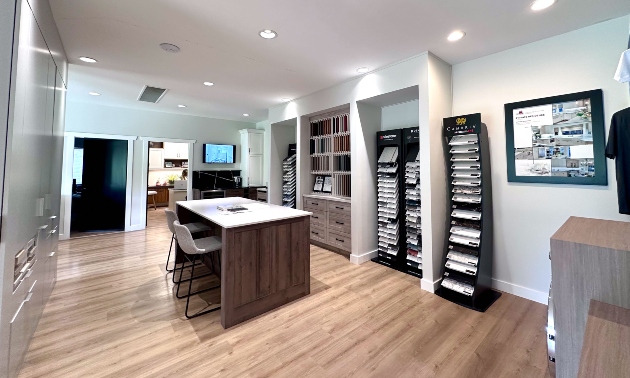
- Kerry Shellborn photo
What are some of your most memorable achievements?
We don't submit a lot for awards or anything like that—we're kind of “fly under the radar” people—but we are part of the Canadian Kitchen Cabinet Association, which is a group of Canadian manufacturers across the country. We get to tour around Canada, see other shops and learn from each other. We have a monthly manufacturer round table where a secret group gets together to talk about what's working, maybe supplier pricing or who's getting what from where, how to solve this customer problem, etc. It's a really good group to to bounce ideas off of. We do it on Zoom every month.
A big topic over the last couple of years has been AI and how that's transforming other industries and impacting the cabinet industry. Actually at our national convention, in Moncton, New Brunswick last fall, I was a speaker. I talked about how we incorporate AI into our business to streamline things because we are small and there are a lot of benefits that AI can bring.
Tell me more about that. How do you use AI in your industry?
I use it a lot on the business side of things and administration. We don't have a receptionist, but we have our website and it's a great tool, so I've trained an AI bot that talks to customers. One of my favourite uses is in building systems. As the owner of a local, family grown business, I didn't get a manual from head office that said “here's how you run a cabinet company.” You're setting the business processes and systems and then you have to train the staff. Well there's an AI tool that came out last year that I can click a button and it will show you how to lay out a kitchen or how to do a certain thing and it captures all of that and gives an explanation. It captures little videos and puts the standard operating procedure together for you; it's done in just five minutes of tweaking it. Then it's good to go and you can fire that off to staff, who can follow that to train.
So in the time it takes me to talk with my employee and show them, it captured all of that and put it into an operating procedure that I could fire off. If I have to share that with another employee, it's already done.
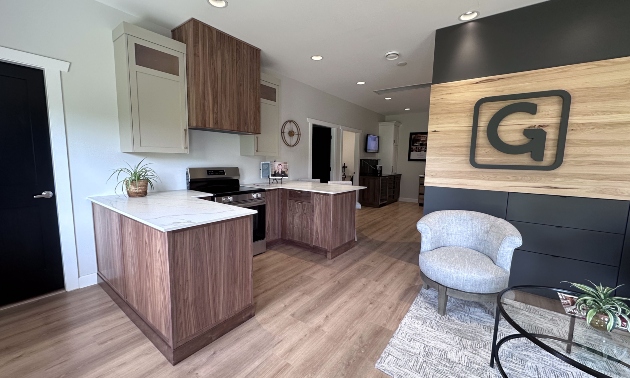
- Kerry Shellborn photo
Tell me about trends in cabinetry design: What are people wanting?
We're moving into a natural era—it's funny, because Cranbrook is uniquely situated where trends are about five years behind. Even with technology and everything, I would say we're still a good three years behind what's actually happening in the industry and the trends you see come across Canada.
They go through the East, hit Toronto, hit Vancouver, a year later hit Calgary, and then we see it. And you absolutely see that on other members in CKCA, their social media and their websites and what they're promoting. You can absolutely see that happening and it's really cool. So being part of the national organization, you can see what's coming. And by the time the products are something my customer wants, I know which ones are the good ones and which ones work, which is fun. So you can make those big cities beta testers. Then we can provide the best product with less hassle and less trial and error. Being part of the national organization, you get to see how things go and ask the important questions before things come up. So right now we're moving into a really natural type of design, really sleek lab fronts, less decorative moldings, really square straight designs, lots of vertical grains, and then use of colour—and colour varies from person to person.
Everybody always wants a white kitchen and that will never go away because even a white kitchen from the 90s is still timeless it's just the door style might not be in style anymore so there's merit to white but it's fun when people play with different colours and textures and we're seeing that.
How did your parents get started in the Kootenays?
My mom originally came to the Kootenays with her family. Her dad was working for BC Hydro, and he moved down here when she was a teenager.
My dad has lived all over the Kootenays. He started working in cabinetry in Sparwood and Fernie, and eventually he met my mom at a house party in Kimberley When they were about 18. They lived in Sparwood and then moved into Cranbrook.
He was doing his apprenticeship, and he had a job here—cabinetry was seasonal work, so he would go out and sell jobs and then take them back to the shop, then go build and install them. That job would end and he’d have to go find more work—so he decided it would be easier to do that himself.
He had his basic machine. He started his own company in 1988, starting off with 2,400 square feet and now he's got 15,000.
How did you end up coming back to the region?
I was living in Lethbridge and I was working for a cabinet shop designing for them. My parents said, "You know, Nikki, if you came home to help us out for a little while, that would be really great." I packed up at Christmas time and started work in January and I’ve been here ever since. I wasn't necessarily planning on sticking around forever. They were getting a bunch of new machinery so somebody needed to learn how to run it all and work with the techs and write the SOPs for that.
I spent my first two years mostly in the shop learning how the systems worked, writing SOPs so we could train new staff, going out and doing site measures with my dad so I could see how the process came together. By my third year I was helping with installs and delivering cabinets. I'd show up to a job site—and in trades most people wear a plaid shirt and jeans with steel-toed shoes—and I had my pink plaid work shirt and my pink steel-toes. I'd haul out all my equipment and all the guys would be like, “you're the cabinet installer?” Yep! I learned how to install, which really helps during the design process, to know what works and what doesn't and why you do things a certain way.
Then I moved into the office, started designing and learned how to sell. I had no idea how to sell (previously) so I took a program with a mentor of mine out of Vernon. I still work with him to this day and we meet every month and I definitely credit him with me being able to sell and to get out of my own way when working with a customer. I don't let what I know about the industry cloud what they're asking for. That's a really hard piece. Like I know how to give them what they want, but sometimes you have to sell, right? So I worked with my mentor, learned a lot, and he made it fun—it isn't scary to sell because I'm bringing their vision to life. I approach everything based on the client and what's going to be functional for them and their budget.
I really love working in the Kootenays because we have a lot of really small, older homes, and those pose a really unique challenge that box store cabinetry isn't going to solve. You end up with weird nook and cranny spaces and with custom cabinetry I can work around that and solve those issues.
Tell me more about the challenges of working with older homes
There is nothing square and nothing's level, and so I always let customers know that their cabinetry will be straight, but it might look weird. We did one house in my early time with the company and the kitchen went straight across the wall. Then there was an island, but from one end to the middle was like a normal toe kick, and then from there to the other end, which is about eight feet, the floor dropped off four inches. I always use that as an example, like if something about your house is not level, and straight cabinetry might show that. And there's nothing I can do about it, because your cabinets need to be level, otherwise nothing's going to stay in your cupboard!
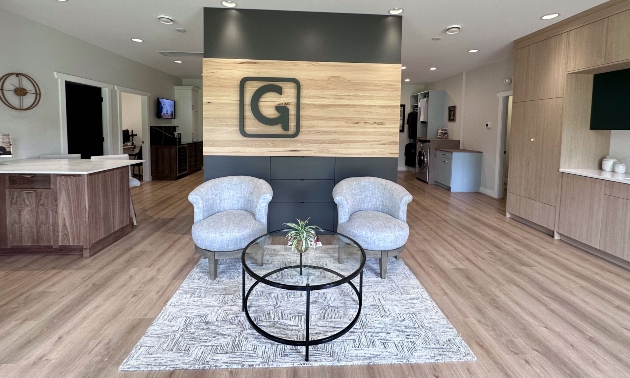
- Kerry Shellborn photo
How do you draw out of clients what they really want?
I have specific questions that I ask and I get them talking more. Sometimes it's just about their life and weekend, their grandkids coming to visit and stuff like that. But that tells me what they do on the daily. I like doing in-homes. I go around and I measure everything. I always bring it back, lay it out in CAD, and then I can start to play with the pieces that are important to the client. Once you start to place those must -haves, then the rest of it's super easy, and you can fill it in with what works.
I don't just go, “here's a kitchen design.” I work through it with them, bring them back in, show them on a screen. I've really cultivated a skill for being able to look at a space and know what it needs. I can envision it, but most people can't. It's a fun challenge and why visuals are so important.
Do you have any personal passion projects beyond what you do here?
I like being involved in the community. I do a lot. I sit on the board for Spirit of the Rockies. I've been working with the Cranbrook Youth Ambassadors since I was a youth ambassador, so I'm going on like 17 years of working with them. Then theatre has always been a passion—so my husband and I have gotten back into that at the Stage Door. We did "Don't Dress for Dinner" and then "Jesus Christ Superstar" and then “Clue,” the last one. We're already gearing up to start the next season next week. I work with the Key City Theatre to help put on their big productions as their production manager. So I oversee the set designing and building cost, and occasionally I act on the stage. The Cranbrook theatre community is blossoming right now. We've got so many talented people and they're creating more opportunities for people, which is so fantastic to see.

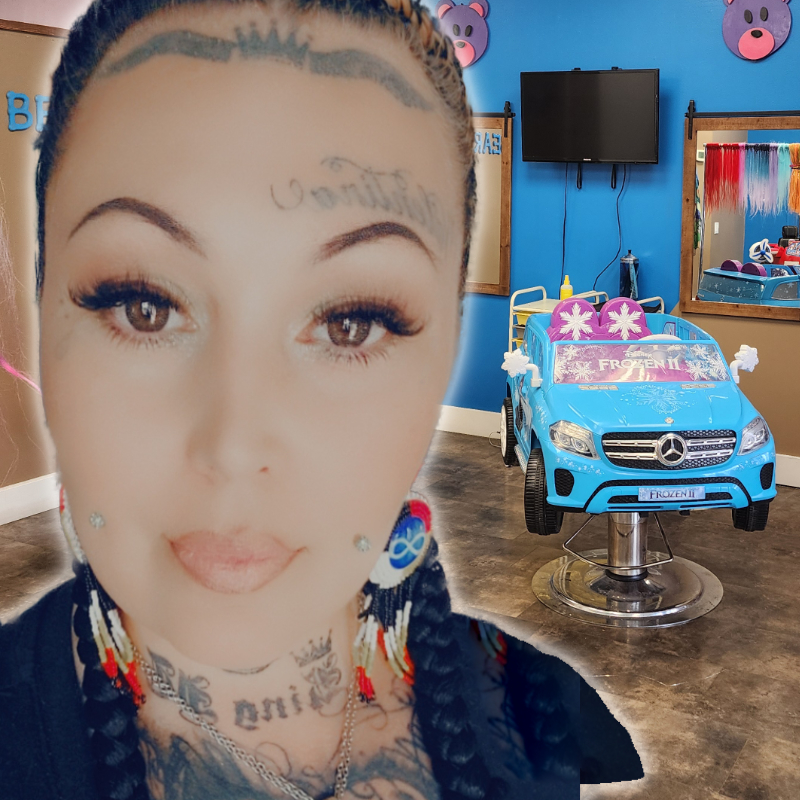
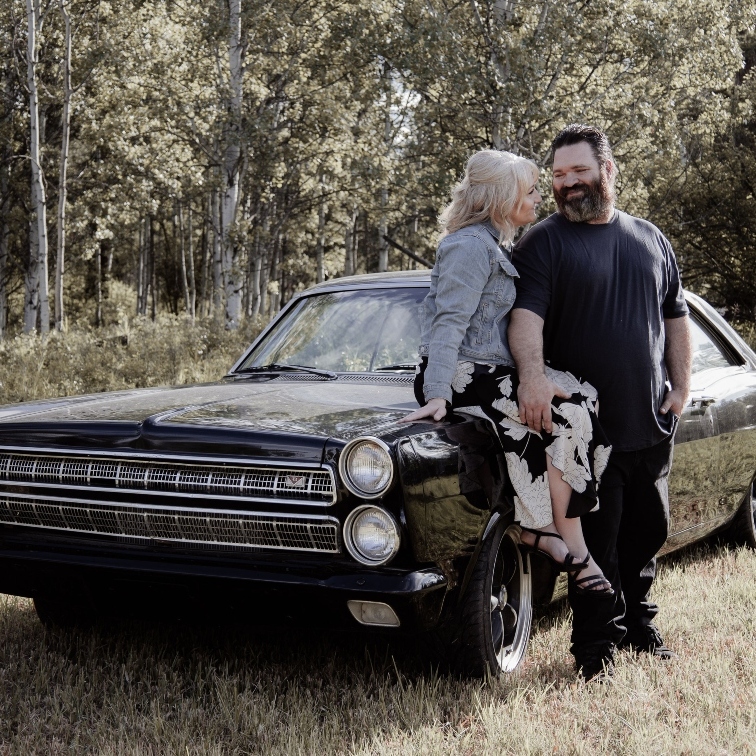


Comments